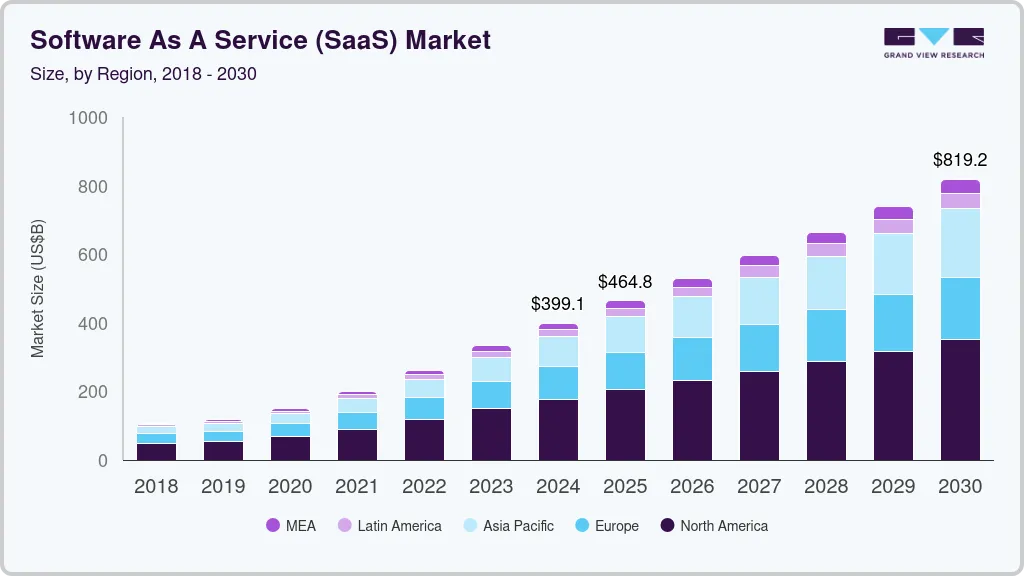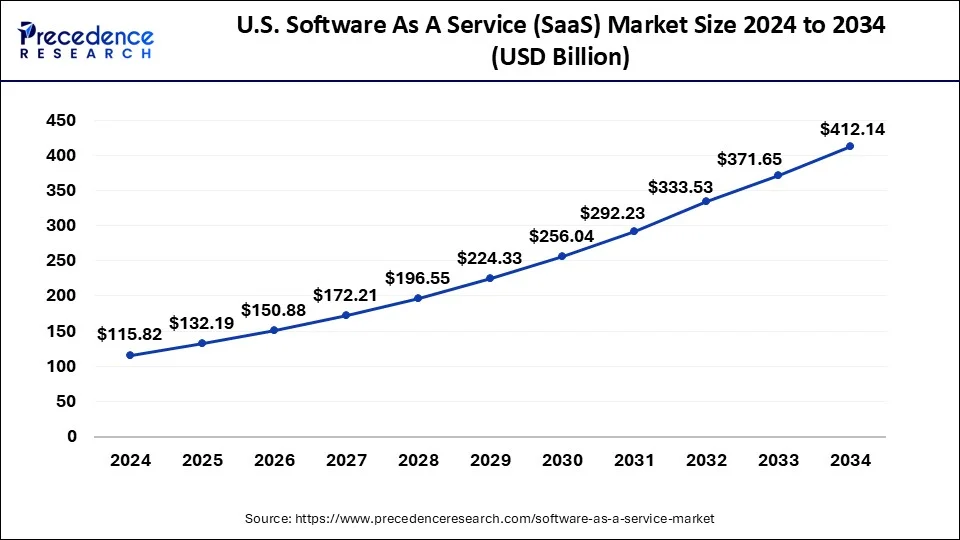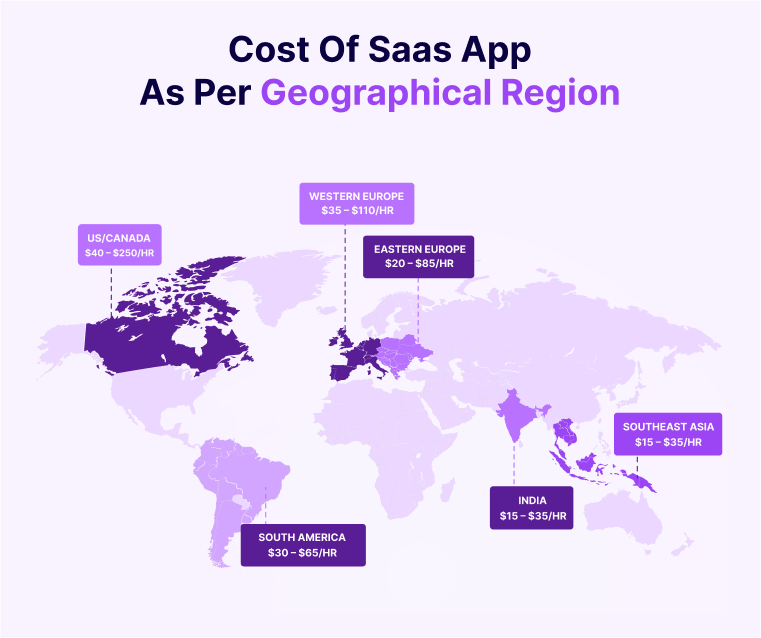Quick Summary :- Thinking of building your own SaaS product? This detailed guide breaks down everything you need to know, from the latest SaaS trends and key challenges to complete cost structures, pricing examples and crucial factors that impact overall development expenses.
Cloud based software has become the standard across industries. From multinational corporations to small businesses, deploying applications via the cloud ensures accessibility, scalability and seamless integration, making SaaS the preferred solution for modern enterprises.
The global Software as a Service market size was estimated at USD 399.10 billion in 2024 and is projected to reach USD 819.23 billion by 2030, growing at a CAGR of 12.0% from 2025 to 2030, reflecting the rising adoption of SaaS solutions worldwide.
SaaS offers ready to use software accessible through web browsers or mobile apps, eliminating the need for complex installations. Popular platforms like Salesforce, AWS and Concur demonstrate how well optimized SaaS products serve diverse audiences efficiently and reliably.
Why Create a SaaS App in 2025?
SaaS development companies offer tremendous opportunities for businesses looking to innovate. Building a SaaS product in 2025 provides several advantages:
- Ready to use solutions: No need to worry about complex configurations or underlying algorithms.
- Cost effective subscription model: Pay only for what you use instead of investing in expensive software upfront.
- Secure cloud storage: Easily and safely store and transfer data without infrastructure concerns.
- Protected intellectual property: Customers don’t have access to the source code, preventing unauthorized use or sharing of your SaaS strategy.
Analysing the SaaS Trends and Statistics
SaaS is the brand-new golden rule for businesses, from conventional accounting firms to cutting-edge AI start-ups, small shops to huge multinational enterprises and tech titans.
The value and need for SaaS products have evolved and grown tremendously over the years, and we can clearly see the trend continue in 2025 and for years to come.
Let’s explore some stats and trends of SaaS:
- In 2025, there are over 30,800 SaaS companies globally, showing a 23% growth from 2021’s 25,000.
- AI powered SaaS is becoming mainstream, with 95% of businesses expected to adopt it by 2025 and over 50% already using generative AI.
- The average global SaaS spend per employee is expected to reach US$115.70 by 2025, reflecting growing software adoption across businesses.
- Around 81% of businesses have automated at least one process using SaaS tools, showing how software boosts efficiency and saves time.
These figures symbolize that the SaaS continues to increase. Growth is constant as businesses grow and is likely to rise for all companies.
Defining the Scope of Your SaaS Application
Before jumping into development, it’s crucial to define the scope of your SaaS. Will it be a platform or a tool? This is one of the biggest factors that determine your SaaS app development cost.
Tools: Focused and Specialized
Tools are restricted in scope and aim to perform one or two functions remarkably well. Examples include Buffer and Hootsuite.
Platforms: Comprehensive and Integrated
Platforms go beyond simple tools. They are fully featured, usually combining multiple tools that interact seamlessly for total functionality. A good example is Facebook.
If you are developing a SaaS for the first time, it’s wise to keep the scope limited. Many underestimate the time and cost required, realizing additional expenses later. Keeping it simple helps avoid financial strain.
The cost of building a tool is significantly lower than that of a full platform. Starting with a tool allows you to add new features later, once your MVP gains traction and revenue.
Choosing a SaaS Development Platform: PC or Mobile
There are two main prospects for SaaS development platforms: PC and Mobile.
Accessibility of your software on both platforms is ideal but it comes at a higher cost.
Why Most B2B SaaS Companies Prefer PC
Most B2B SaaS companies find desktop platforms more practical for their services. Since employees primarily work on desktops, integrating SaaS solutions there is the most productive and efficient approach.
For start ups, it’s advisable to begin SaaS development with the PC platform to ensure a productive and stable launch.
Avoid Building Mobile SaaS Too Early
At the initial stage of your business, it’s better to avoid developing a mobile SaaS system.
Mobile app development requires a completely different approach, smaller screens, different orientation and a distinct user experience (UX) that still needs to feel consistent with the desktop version.
It’s usually easier to downscale a PC UX for mobile later than to build upward from mobile to desktop.
Understanding the Cost Difference
The expense of SaaS app development can range from half to double the cost of the original web app. For instance, if your project originally cost $50,000 you may need to invest an additional $25,000 – $100,000 to develop a mobile app depending on your service.
This could quickly increase your SaaS cost structure beyond your initial estimate. It’s often smarter to focus on one platform first, generate revenue and then expand to another platform with clear customer demand.
Challenges of SaaS Application Development
SaaS Development comes with a lot of advantages as well as challenges and pitfalls that users may experience. This includes major three challenges which are;
Poor Execution
Usually, upon the collapse of any software development or business, people blame just the idea,
But in reality, it is not always the bad idea that causes the failure but sometimes a good idea fails if the execution is poor.
Poor execution is the greatest challenge to address before calculating the Cost to Develop SaaS Application.
Small Target Audience
In Spite of the upward and consistent development graph, it is very unsafe to choose a course that is way too different and unique.
As a solution provider, it is essential that one has to refresh, update, and optimize the solutions frequently. In the case of a smaller group of audience, your business would fall into losses.
Lack of Trust
Trust is the most significant determinant in the development of business or app development. The absence of trust implies less customers.
The problem is largely intense with the SaaS model as it protects a large volume of user data, which makes it extra vulnerable.
SaaS App Development Cost Structure
Here are some ongoing expenses to develop and manage a SaaS;
Phone Line
For a team with fewer members, you can reasonably get off with just one phone line, but you’ll end up requiring few networks, mostly two – one for the office, and other for assistance.
Your employees should be able to communicate, and your company necessitates to be competent in handling customer queries.
A compact team of trained executives is essential to manage the customers’ perspective. Also, you will require a network inside the office where the SaaS product is being worked.
Hosting
This is for the website and/or app. Either of the applications is going to claim a hosting service to back its functionalities.
So, you need to take this into consideration for calculating the Cost to Develop SaaS Application.
Insurance
For almost everything. Starting from the facilities to the workers, from everyone to everything that can be insured.
Especially for the first-class merchandises, insurance cover is an absolute essential to shield yourself from inevitable obstructions.
Therefore, you need to take this into account while calculating the Cost to Build SaaS Application.
Software
This means examining and picking a complete suite of specialized software, that includes but is not limited to: tracking, meeting, billing, project management, and CRM (Customer Relationship Management) software.
Continuing Development
It’s a highly competitive world today. If you just release a SaaS into the marketplace, you might perform well for initial few weeks or even some months, but without consistent backing and updating, your service will quickly fall back on what customers demand.
Even if your service is provisioned to a niche market, it is only an affair of time before someone else takes your idea, improves your service offerings and steals the show. Continued improvement and development help to ensure or upgrade your status in the market.
Staff
Out of everything that is required for managing a SaaS business, skilled staff are the most significant. They establish and execute new innovations; Also, they guarantee that any difficulties that occur are managed with agility, urgency and refinement.
They are the face of your company in front of everyone, every customer who needs support. Of course, the more you care for and pay the staff, the more agreeable and more penetrating your hiring pool becomes.
📊 US Market Insight
The U.S. SaaS market is valued at $115.82 billion in 2024 and projected to hit $412.14 billion by 2034, growing at a 13.53% CAGR.
Cost to Develop SaaS Application: Time-Specific Analysis
There is no doubting that time is money. There will even be costs for the amount of time spent on developing the SaaS product. Here are a few things to consider in this aspect:
Validation
This process involves a series of activities that demand about 10-50 hours. This includes determining the proper clients, finding potential competitors, managing customers, etc.
Planning
The planned projects that are designed well always prove to be better in functionality. Therefore, investing time on planning to guarantee quality and accuracy is best. This would demand 30-200 hours, depending on the scope of your product.
UX Design
Operating on the aesthetics to make a stellar design to captivate the buyers of the SaaS product is important. This takes around 25-200 hours.
Project Management
Managing the diverse phases of the development is as vital as the development of it. This takes around 20 percent of the time.
Each of these activities needs to be accounted for when calculating the costs of building the SaaS product.
Cost to Develop SaaS Application: Analysing Various Factors
The cost of building a SaaS application is higher than any other application or website. It is a primary concern of any company that wishes to get an app developed for its business operations.
There are various aspects that you as an application owner needs to decide to plan your SaaS app effectively.
You can manage the expenses related to the development of your SaaS application by considering 5 important price-related factors before the development of your application.
Outsourcing
As per your business requirements, you can choose among onshore, offshore and nearshore outsourcing. These three are different kinds of outsourcing that are available and each one has its own advantages.
You can choose one of them depending upon your requirements and the skills that you need in your app developers. The trainers contain a particular skill set depending on the location that they are trained at.
Budget
By deciding the ownership expenses, you can decide the application budget. The total ownership expenses are calculated on the basis of updates, licensing, training/technical support and subscription cost.
You should be sure enough that you would be able to manage the Total Cost of Ownership(TCO) after the first year as well. It playes a major role in the Cost to Develop SaaS Application.
You have to consider the opportunity cost as you might not be able to spend that stack on the core competencies of your business.
This is likely to be the case for every business organization that plans to put its money in advance for the software solutions.
The time duration for the development of your SaaS application might stretch from 6 months to a complete year and thus you must be able to have a realistic idea related to the expenses that you would need to manage monthly as well as for the longer term.
Features
Make a complete list distinguishing the must-have app features and the Wishlist features. The cost of an application containing complex features is more than other simple applications.
You can choose to mitigate the development cost by reducing some of the complexities provided that your chosen reductions do not cut the overall value of the app.
Your application should be user-friendly at the end of the day. You can go for more robust software solutions if you wish to make an empowering application.
If you are going to launch your application on cross platforms then that would be more expensive than the one that is launched on one single platform.
However, it has been evident that the cross-platform applications are subject to better success. You can attain Asp.net development services from a reputed company that is known to provide quality SaaS app development for years.
API Integration
Most of the SaaS applications contain backend functionality. You can decide whether you want these features to be developed using the API integration or from the very beginning.
It is quite obvious that the cost of API integration is lesser than the cost of building the backend features from scratch.
With API integration you can rapidly scale your business and it also reduces the time of development by cutting many steps in between.
It is not a smart choice to reinvent the already existing SaaS app architecture. You do not make the best use of your budget while making such choices over API integration.
Overhead Cost
There are a variety of overhead costs related to SaaS mobile app development. Let’s understand it in detail: –
No One-time Cost
Do not consider the app development cost as one-time thing because it does not end once your app gets developed and gets ready for deployment.
For example, deciding upon the medium of attracting the target users towards your application. You have to calculate the marketing and advertising costs.
This is quite fundamental as a step. And it can be ongoing as well.
Legal Costs
There are federal, local and state laws that one needs to comply with and we need to pay the expenses related to compliance when the application is in its developmental process.
Accounting Cost
With an increasing subscriber base, the bookkeeping cost grows as the volume of monthly transactions increases. You would also require assistance with the tax-related advice, financial statement preparations as well as auditing.
System Specific SaaS App Development Cost
Here are a few more system specific SaaS costs:
Coding and Development
This step is self-explanatory and this is where the majority of the particular creation takes place.
It is what most SaaS creators deem as the bread and butter of the project and it is so in some ways, since this is what makes your system truly do what it’s meant to do.
This is likely going to be the most high-priced task when it’s all said and done; especially because this step will likely have smaller echoes between each of the subsequent steps.
Building in Other Systems
More coding, essentially, but adding in additional functionality also means ensuring that your system plays nicely with others.
The simplest thing here is enabling auto-emails from your server to users or users’ clients upon completion of various tasks.
You could further unite your software with different systems. What works best for your SaaS will depend upon what you’ve designed it for.
Building Tests
You will desire to test the system and you might be considering alternatives to do that manually.
If you test manually, you’ll be paying someone (or a team) for every working hour spent and this won’t be a one-time cost.
It is recommended that you spend the time upfront to build in automated tests since it will save you money in the long run.
If the testing process for various elements is automated, then errors are easier to find and less time is wasted. These tests will still be useful after release and can end in a higher-quality product.
Alpha and Beta Testing
It is ill-advised to release your product without extensive testing. Alpha and Beta tests allow you to urge valuable feedback from people that may become customers.
If you sat down with any potential customers in the Validation step, they may be willing to help you test out the service.
During these tests, aim to gather as much feedback as possible – and ignore the negative feedback at your own peril.
Release and Marketing
Lastly, you’ve got to believe your SaaS release to the general public – and you would like to plug your release.
Marketing is going to be essential for drawing in users, and an idea for marketing should be discussed alongside everything else within the drawing board.
You also need to make sure that other elements, like Customer Relationship personnel and drip emails, are on point.
User testing and analytics need to be running non-stop in the first few weeks or months in the market. In other words, expect to be at your busiest when your product is released; this is not the time to kick up your feet.
Things to Consider Through SaaS App Development
There are several other things to consider when your SaaS development work is on like…
User Management
This is how your users log in and log out, to start with. But remember, the users also should be able to edit their profiles, change their passwords, add or remove members and modify teams and much more.
This is one of those spaces which gives you a comfortable opportunity to influence your users. Expect to add 25-100 extra hours to your UX Design step precisely for this factor of the SaaS.
Pricing Flexibility
Then, there’s the pricing. Neutralizing your cost to build a SaaS, and ensuring the software is effective and profitable, is going to be dependent on how much you beget coming in.
Keep a clear aspect in mind to guarantee profitability and elasticity in pricing. If you know about the SaaS Pricing Models, it will be helpful to you all in the long run, without a doubt.!
Paywall
Surely, the primary three-tier system may work for a year or more, but as you continue to attach and customise features and welcome feedback from your customers, you may determine that supplementing the fourth tier and accommodating prices might be the best call.
But it would unquestionably be a bad idea to double the prices overnight for existing loyal customers. Putting up a paywall at the start is a great idea!
No matter what your opening prices are, if you’re not seizing orders from the start you’ll be missing out on money, profit and loyal customers.
The Total Cost to Build SaaS Product
The Cost to Develop SaaS Application typically closes up to somewhere in the range between $15-100k, with the bulk bending more toward the centre.
For the SaaS Platforms, the range is larger, settling anywhere between $50-250k. This is because platforms have more enhanced and extra features, ergo, more extended time and money in both planning, execution and development.
The final question is, How Much Does It Cost to Develop SaaS App? The end cost is principally dependent on the number of times you need to backtrack to reconsider, redesign your functionality, design, or how the system will rightly fit your users.
P.S – One of the most expensive blunders we see more often, unfortunately, is a client who has already wasted half of their budget (sometimes even more) only to abandon the original build due to faulty or poor planning and a decreased development team.
Cost Comparison: Freelancer vs Agency
When it comes to costs, freelancers are generally less expensive. Agencies tend to charge more because their pricing includes overheads like project management, quality assurance, office expenses, and administrative support. However, agencies also provide structure, accountability and guaranteed delivery factors that are often worth the extra cost.
Reliability and Project Continuity
One major concern with freelancers is project abandonment. If a freelancer quits mid-project, it becomes your sole responsibility to find and onboard a new developer. This handover can be time consuming and frustrating.
In contrast, if an agency developer leaves, the agency takes full responsibility for replacing them and ensuring a smooth continuation of work. Many top tier developers also avoid projects abandoned by others, as they don’t want to clean up incomplete or messy code.
Why Agencies Are the Safer Choice
For these reasons, partnering with an agency is often the safest and most reliable option. If your freelancer leaves unexpectedly and your SaaS project remains unfinished, it’s best to switch immediately to an agency to avoid further delays or quality issues.
Agencies provide a complete team of experts, including designers, developers, and project managers, so you don’t need to worry about hiring, screening, or managing individual professionals.
Read also: Frequently Asked Questions About SaaS (Software as a Service)
SaaS App Development Cost: As Per Geographical Region
Even though an agency is highly recommended, there are several underlying factors to consider as well for hiring, both for agency and freelancers.
- Agency – location of agency, outsourcing – offshore, or onshore
- Freelancer – Cost, location, experience
Talking of this, for freelancers, it is always important to decide where you hire them from as their price varies from region to region. To clarify, below is a rough rundown of the Cost to Build SaaS Application as per the geographical region:
- India: $15-35/hr
- Southeast Asia: $15-35/hr
- Eastern Europe: $20-85/hr
- Western Europe: $35-110/hr
- South America: $30-65/hr
- US/Canada: $40-250/hr
Some Real-World SaaS Pricing Examples
By now, you have a fair idea of the cost factors that influence SaaS development and how to bring them together for effective project planning. Let’s now take a look at a few real world SaaS pricing examples that show how much projects actually cost based on their complexity and scope.
1. MVP Level SaaS Project
The smallest spend for a SaaS project with a successful MVP was around $15,000. This included the basic features required to validate the product idea and gain early users.
2. Advanced Form Building & Survey System
A niche business spent about $85,000 over three years developing an advanced form building and survey application. The project included three development phases of two to three months each, along with extensive testing and refinement.
3. Directory Service with Data Mining
A directory service featuring advanced search capabilities and a powerful admin dashboard was developed for around $30,000. The project involved manual data mining, centralizing information into a single database and implementing enhanced data-entry tools to boost employee productivity.
4. Healthcare Practice Management Solution
A healthcare management service that integrated with hospital tools, billing, and insurance systems took several years and cost approximately $500,000 to build. Although not a pure SaaS product (since it lacked user accounts), the system required extensive backend development and secure data integrations.
The total cost of SaaS development ultimately depends on your decisions, both technical and strategic. Investing wisely in the right areas enhances your system’s quality, structure and long term profitability.
Also Read: Top 10 SaaS Development Companies in 2025
Final Words
The cost of building a SaaS platform depends on informed decisions, clear priorities and well managed resources. Careful planning helps ensure every dollar spent contributes meaningfully to quality, performance, and long term success. With the right assortment of information, you become able to assess where to spend the money to get maximum and fruitful returns safely.
It is also important to identify the cutting corners. Most of the phenomenal SaaS Application Development projects are made out of a burning desire, sheer passion and are delivered to make a striking influence on the way business operates. If you have any amazing and out of the box ideas, go for it and be sure to consider the factors discussed in this article.
Frequently Asked Questions
How Much Does It Cost To Build A SaaS Application?
There can not be a fixed price for developing a SaaS application. It varies from one region to another and also depending on the requirements. However, the average cost in the US is around $30k-$50k.
How Long Does It Take To Build A SaaS Product?
Generally, it takes around 2-10 months for building a SaaS MVP. But, for larger products, it could take more than that as well.
What Is SaaS In Cloud Computing?
SaaS is an acronym for Software as a Service. It is a software model where any 3rd party provider hosts the application and makes it available to all the customers through the internet facility.
What Are The Factors That Affect The SaaS App Development Cost?
There are a variety of factors that you need to take into account while calculating the SaaS application development cost. They are as follows:
- Cost To Consider Before Development
- Type Of Platform
- Geographical Region
- Scope Of The Application
- Time-Specific Factors
What Are The Other Famous Names For SaaS?
Software as a Service is a popular alternative for SaaS applications. Many people also refer to it as ASP Services or software on demand.
Is Amazon a SaaS Product?
The simple answer to this question would be YES. Amazon is a SaaS product that provides reliable as well as secure services to all customers.





